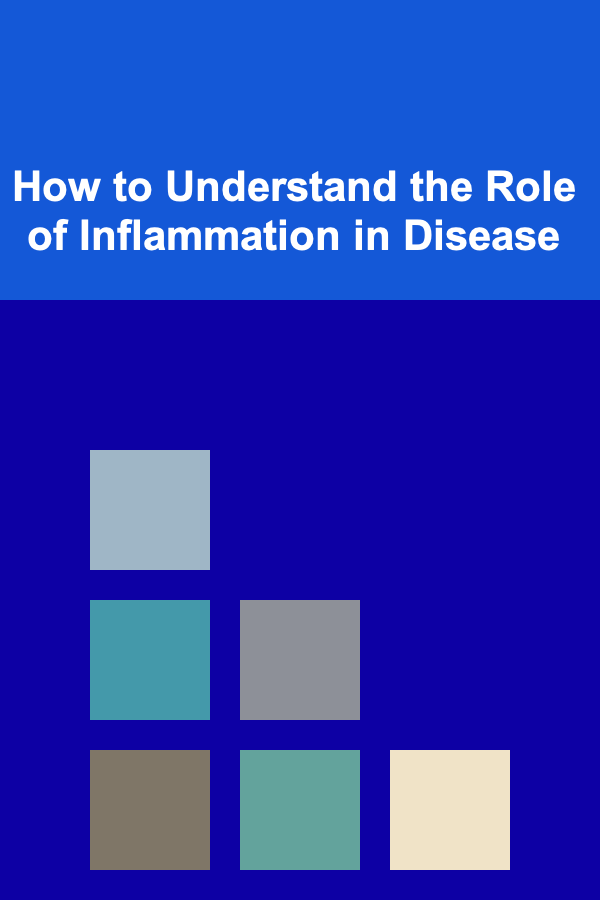
How to Understand the Role of Inflammation in Disease
ebook include PDF & Audio bundle (Micro Guide)
$12.99$9.99
Limited Time Offer! Order within the next:

Inflammation is a natural response of the body to harmful stimuli, such as pathogens, damaged cells, or toxic compounds. It is a critical part of the immune system's defense mechanism and is essential for survival. However, when inflammation becomes chronic or dysregulated, it can contribute to a wide range of diseases. Understanding the role of inflammation in disease is crucial for developing better therapeutic strategies and improving patient outcomes.
This article will delve into the mechanisms of inflammation, its role in various diseases, and how inflammation can be both a protective and harmful process. By exploring the biology of inflammation and its links to different disease states, we will gain insight into why inflammation is central to both acute and chronic health issues.
What is Inflammation?
Inflammation is a complex biological response to harmful stimuli, including infection, injury, or harmful environmental factors. It is part of the body's innate immune response and involves various cells, signaling molecules, and molecular pathways.
Types of Inflammation
There are two main types of inflammation: acute and chronic.
- Acute Inflammation: This is a short-term response to injury or infection. It usually resolves after the harmful stimulus is eliminated, and the tissue returns to normal. Acute inflammation is characterized by the classic signs of redness, heat, swelling, pain, and loss of function. It typically involves immune cells such as neutrophils, macrophages, and the release of signaling molecules like cytokines and prostaglandins.
- Chronic Inflammation: This is a prolonged inflammatory response that persists even in the absence of the initial harmful stimulus. Chronic inflammation can lead to tissue damage and is implicated in a wide range of diseases, including autoimmune disorders, cardiovascular disease, cancer, and neurodegenerative diseases. Chronic inflammation is often driven by the continued activation of the immune system, which can result in an overproduction of pro-inflammatory molecules like TNF-alpha, IL-1, and IL-6.
Key Players in Inflammation
Inflammation involves the interaction of several components of the immune system. These include:
- Immune Cells: The main players are white blood cells, including neutrophils, macrophages, dendritic cells, T-cells, and B-cells. These cells migrate to the site of infection or injury and release inflammatory mediators to orchestrate the immune response.
- Cytokines and Chemokines: These are signaling molecules that help regulate immune cell activity and promote inflammation. Cytokines such as interleukins (ILs) and tumor necrosis factor (TNF) are essential in mediating the inflammatory response.
- Mediators of Inflammation: These include molecules like prostaglandins, leukotrienes, and histamines, which contribute to the classic symptoms of inflammation such as pain, swelling, and redness.
Inflammation in Acute Disease Processes
Acute inflammation is a protective response aimed at eliminating harmful agents, such as pathogens or damaged cells. It also promotes tissue repair. However, the failure to resolve acute inflammation properly can lead to chronic inflammation and tissue damage.
Infections
Infections by pathogens such as bacteria, viruses, and fungi are among the most common triggers for acute inflammation. Upon detection of pathogen-associated molecular patterns (PAMPs), the immune system activates a cascade of inflammatory responses. This process helps eliminate the pathogen but can also cause tissue damage if the inflammation is not properly controlled.
For instance, sepsis, a severe systemic infection, results from the widespread activation of inflammation throughout the body. While the body's response to infection is initially protective, uncontrolled inflammation in sepsis can lead to widespread tissue damage, organ failure, and death.
Tissue Injury
Physical trauma, burns, or exposure to toxins can trigger acute inflammation. The body recognizes cellular damage and releases inflammatory mediators that recruit immune cells to the site of injury. The inflammatory response helps clear dead cells and pathogens and promotes tissue repair. However, if the injury is severe or healing is impaired, chronic inflammation may develop, leading to fibrosis or scar tissue formation.
Allergic Reactions
Allergic reactions are another example of acute inflammation. They occur when the immune system overreacts to harmless substances, such as pollen, pet dander, or certain foods. The release of histamines and other inflammatory mediators leads to the symptoms of an allergic reaction, such as swelling, itching, and difficulty breathing. In some cases, this response can lead to chronic conditions like asthma or allergic rhinitis.
Inflammation in Chronic Disease
While acute inflammation is a temporary and usually beneficial response, chronic inflammation is associated with various long-term diseases. Chronic inflammation can result in sustained tissue damage, dysfunction, and disease progression. The transition from acute to chronic inflammation is influenced by genetic factors, environmental exposures, and the inability of the immune system to resolve inflammation properly.
Cardiovascular Disease
Chronic inflammation plays a significant role in the development of cardiovascular diseases, including atherosclerosis and heart disease. In atherosclerosis, the buildup of fatty plaques in blood vessels triggers an inflammatory response. Over time, this inflammation leads to plaque rupture, blood clot formation, and heart attacks. Inflammation is also involved in the progression of other cardiovascular conditions, such as hypertension and heart failure, where persistent immune activation damages the heart and blood vessels.
Cancer
Inflammation is a well-established factor in cancer development. Chronic inflammation can create an environment that promotes tumorigenesis by providing growth factors, promoting blood vessel formation, and suppressing immune responses that would normally eliminate cancer cells. Cytokines like TNF-alpha and IL-6, which are involved in inflammation, have been linked to cancer promotion in several tissues, including the colon, liver, and pancreas. Moreover, inflammatory cells like macrophages and neutrophils can foster a pro-tumor microenvironment by producing factors that support cancer cell proliferation and survival.
Neurodegenerative Diseases
Chronic inflammation in the brain, also known as neuroinflammation, is implicated in several neurodegenerative diseases, such as Alzheimer's disease , Parkinson's disease , and multiple sclerosis. In these conditions, prolonged activation of the immune system in the brain leads to the damage and death of neurons. Microglia, the resident immune cells of the brain, become overactive and release pro-inflammatory cytokines, which contribute to neuronal injury and disease progression. The exact role of inflammation in these diseases is complex and remains an area of active research.
Autoimmune Diseases
In autoimmune diseases, the immune system mistakenly attacks the body's own tissues, leading to chronic inflammation and tissue damage. Conditions such as rheumatoid arthritis , lupus , and inflammatory bowel disease (IBD) involve the persistent activation of immune cells that target specific organs or tissues. In these diseases, inflammation is not resolved after the initial injury, and immune cells continue to attack healthy tissues, leading to chronic pain, organ damage, and reduced function.
Metabolic Disorders
Inflammation is also a key factor in metabolic diseases such as type 2 diabetes, obesity, and metabolic syndrome. In these conditions, low-grade, chronic inflammation is often present and contributes to insulin resistance, adiposity, and other metabolic disturbances. Adipose tissue in obese individuals can release pro-inflammatory cytokines, which can interfere with insulin signaling and contribute to the development of metabolic diseases. In fact, obesity is often considered a state of chronic inflammation, with immune cells being activated in response to excess fat storage.
The Balance: Protective or Harmful?
Inflammation is a double-edged sword. While it is necessary for protecting the body against infection and injury, excessive or chronic inflammation can have detrimental effects. The key to healthy inflammation lies in its resolution---once the harmful stimulus is cleared, inflammation should subside, allowing for tissue repair and recovery. However, when inflammation fails to resolve, it becomes pathological and contributes to a wide range of diseases.
Factors Influencing Inflammation
Several factors influence the progression from acute to chronic inflammation. These include:
- Genetic predisposition: Certain genetic factors can increase susceptibility to chronic inflammation and related diseases. For example, specific gene variations can lead to hyperactivity of the immune system.
- Diet: Diets high in refined sugars, trans fats, and processed foods can promote inflammation. On the other hand, diets rich in antioxidants, omega-3 fatty acids, and fiber can reduce inflammation.
- Environmental exposures: Pollution, smoking, and chronic stress are environmental factors that can trigger or exacerbate chronic inflammation.
- Gut microbiome: The bacteria in the gut play a significant role in regulating inflammation. Dysbiosis, an imbalance in the gut microbiome, can contribute to chronic inflammation and disease.
The Resolution of Inflammation
An important aspect of inflammation is its resolution. The body has mechanisms to actively resolve inflammation, which involves the removal of inflammatory cells and the repair of tissues. This process is regulated by specialized pro-resolving mediators, including resolvins, protectins, and maresins. Impaired resolution of inflammation can lead to persistent inflammation and tissue damage.
Conclusion
Inflammation is a fundamental aspect of the immune system, protecting the body from infection and injury. However, when inflammation becomes chronic or dysregulated, it can contribute to the development of various diseases, including cardiovascular disease, cancer, autoimmune disorders, and neurodegenerative conditions.
A deeper understanding of the role of inflammation in disease is essential for developing effective therapies. By targeting the underlying causes of chronic inflammation and promoting its resolution, we can potentially improve outcomes in a wide range of diseases. Continued research into the molecular mechanisms of inflammation, coupled with advancements in personalized medicine, holds the promise of better treatments and strategies to combat inflammation-related diseases.
How to Create Custom Dashboards for Campaign Tracking
Read More
How To Master Snowboarding Tricks for Beginners
Read More
How to Set Up a Family Room Snack Station for Movie Nights
Read MoreMastering Creative Direction: Essential Skills for Building Iconic Brands
Read More
How To Master Building a Brand Around Your POD Products
Read More
Conquering Shyness: Your Guide to Confident Language Speaking
Read MoreOther Products
How to Create Custom Dashboards for Campaign Tracking
Read More
How To Master Snowboarding Tricks for Beginners
Read More
How to Set Up a Family Room Snack Station for Movie Nights
Read MoreMastering Creative Direction: Essential Skills for Building Iconic Brands
Read More
How To Master Building a Brand Around Your POD Products
Read More